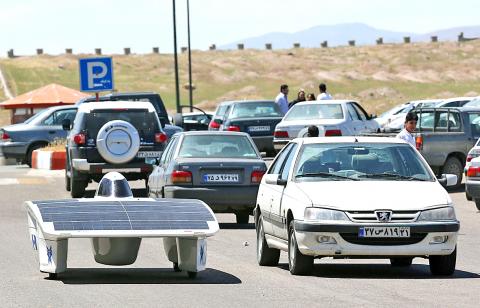It is not easy for an Iranian to visit the US. With no US embassy in Tehran since 1979, obtaining a visa usually requires two costly trips to Dubai or Turkey.
However, a group of Iranian students have a far bigger problem — they want to send a car to the US. Only then will they get on a plane.
The Havin-2 is no ordinary vehicle. Solar powered, its 4.5m carbon fiber chassis resembles a giant door. The four wheels that lurk beneath its sprawling white body are the only clue it is a car at all.

Photo: AFP
As entrants to the American Solar Challenge, a 2,735km road trip next month across seven US states from Austin, Texas, to Minneapolis, Minnesota, a lot is at stake for the young Iranians.
However, the sad reality is that the Havin-2 may never reach the start line.
“We are really worried about it,” said Mohammad Saadatmand, the mechanical leader of the team from Qazvin Azad Islamic University, west of Tehran.
“To think that we might not make it is almost too terrible to contemplate,” he said.
The road block they face is more daunting than consular paperwork.
Standing in their path are the sanctions imposed on Iran by the US and other world powers as punishment for a nuclear program that many believe masks an intention to develop an atomic bomb.
The restrictions make transporting the Havin-2 by air cargo a logistical nightmare.
The Iranian team is confident it can hold its own against the mostly US competitors, which includes the illustrious Massachusetts Institute of Technology (MIT). The question is whether they will get the chance.
“This car has made us crazy,” said Alireza Malmali, the team’s electronics specialist who has now switched his attention to trying to find an air carrier.
Giving a tour at the team’s spartan workshop, where the Havin-2 lurks under a tarpaulin, the prospect of being barred is writ large across his face.
“I wish governments across the world would accept we are researchers, not terrorists,” he said.
The cargo arms of Qatar Airways, Turkish Airlines and Lufthansa all refused to carry the Havin-2, citing fears of breaching sanctions.
Several other companies set impractical conditions for carriage.
A letter from the US Department of Treasury appears to confirm that the car does not require special authorization if is being used “in a public conference, performance, exhibition or similar event.”
However, the solar challenge organizer were unable to navigate the regulations.
“It has been very difficult,” said Sue Eudaly, the event’s team coordinator. “We went to a senator, who directed us to the State Department who then sent us to the Office of Foreign Assets Control. Ultimately, I guess we were not a high priority case.”
Last ditch negotiations with a Tehran-based carrier are now under way.
Even then, a delivery date no later than July 1, which the carrier is reluctant to guarantee, leaves less than two weeks for the Havin-2 to clear customs in time for the start of the race.
The costs of sending the team and the car to the US mean only 12 of the 18 students involved, all of whom have obtained visas, will travel.
Located 160km from the capital, Qazvin has 300 days of sunshine a year. Good roads stretch for kilometers across a largely barren desert landscape.
To ensure a level playing field in the US, all teams will rely on 516 photovoltaic panels, or solar cells, made in the US and patched together in Germany.
However, each entrant has developed their own Maximum Power Point Tracking system, which connects inverters, battery chargers and other devices to optimize the car’s performance.
The skill and key to winning is understanding the course and detecting the angles of the sun’s rays during a day’s racing, starting at 9am and ending at 6pm, with each team using four drivers.
The Havin-2 reached a top speed of 110kph during testing, but the team believes it is capable of 160kph in competition.
Beyond the solar challenge’s aim of promoting clean energy, a sense of national pride is also palpable among Saadatmand and Malmali, who both took part in the same event in Australia three years ago.
“We want to show we are good, maybe even better than the rest of the world,” Malmali said.

IN THE AIR: While most companies said they were committed to North American operations, some added that production and costs would depend on the outcome of a US trade probe Leading local contract electronics makers Wistron Corp (緯創), Quanta Computer Inc (廣達), Inventec Corp (英業達) and Compal Electronics Inc (仁寶) are to maintain their North American expansion plans, despite Washington’s 20 percent tariff on Taiwanese goods. Wistron said it has long maintained a presence in the US, while distributing production across Taiwan, North America, Southeast Asia and Europe. The company is in talks with customers to align capacity with their site preferences, a company official told the Taipei Times by telephone on Friday. The company is still in talks with clients over who would bear the tariff costs, with the outcome pending further

A proposed 100 percent tariff on chip imports announced by US President Donald Trump could shift more of Taiwan’s semiconductor production overseas, a Taiwan Institute of Economic Research (TIER) researcher said yesterday. Trump’s tariff policy will accelerate the global semiconductor industry’s pace to establish roots in the US, leading to higher supply chain costs and ultimately raising prices of consumer electronics and creating uncertainty for future market demand, Arisa Liu (劉佩真) at the institute’s Taiwan Industry Economics Database said in a telephone interview. Trump’s move signals his intention to "restore the glory of the US semiconductor industry," Liu noted, saying that

STILL UNCLEAR: Several aspects of the policy still need to be clarified, such as whether the exemptions would expand to related products, PwC Taiwan warned The TAIEX surged yesterday, led by gains in Taiwan Semiconductor Manufacturing Co (TSMC, 台積電), after US President Donald Trump announced a sweeping 100 percent tariff on imported semiconductors — while exempting companies operating or building plants in the US, which includes TSMC. The benchmark index jumped 556.41 points, or 2.37 percent, to close at 24,003.77, breaching the 24,000-point level and hitting its highest close this year, Taiwan Stock Exchange (TWSE) data showed. TSMC rose NT$55, or 4.89 percent, to close at a record NT$1,180, as the company is already investing heavily in a multibillion-dollar plant in Arizona that led investors to assume

AI: Softbank’s stake increases in Nvidia and TSMC reflect Masayoshi Son’s effort to gain a foothold in key nodes of the AI value chain, from chip design to data infrastructure Softbank Group Corp is building up stakes in Nvidia Corp and Taiwan Semiconductor Manufacturing Co (TSMC, 台積電), the latest reflection of founder Masayoshi Son’s focus on the tools and hardware underpinning artificial intelligence (AI). The Japanese technology investor raised its stake in Nvidia to about US$3 billion by the end of March, up from US$1 billion in the prior quarter, regulatory filings showed. It bought about US$330 million worth of TSMC shares and US$170 million in Oracle Corp, they showed. Softbank’s signature Vision Fund has also monetized almost US$2 billion of public and private assets in the first half of this year,